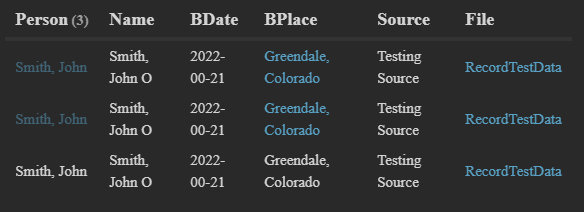I’m currently using Obsidian for my genealogy research. I’m trying to track multiple people and their information that’s mentioned in multiple documents and I’d like to use dataview to view some of the information but I don’t know if it’s possible to do it.
If I have a document that mentions several people, I’ll tag each person and the relevant data for each person. Some of the fields could be blank, and the number of people mentioned won’t always be the same from one note to the next. For example the fields in one document note could look like this:
person1_name: [[Smith, John]]
person1_birthplace: [[Springfield, Illinois]]
person2_birthdate:
person2_name: [[Doe, Jane]]
person2_birthplace: [[Greendale, Colorado]]
person2_birthdate: 2022-07-21
I’d like to search for any of this data and have it displayed along with the person it connects to. So if I query dataview to search both person1_birthplace and person2_birthplace for “Greendale” in my documents folder, I’d like it to display in a table every person attached to that location and their other data from the document, whether they’re under person1 or person2. In this case, it would only display all the information of [[Doe, Jane]] from this note, nothing from anyone else in the note.
Is there any way I can do this with dataview?
